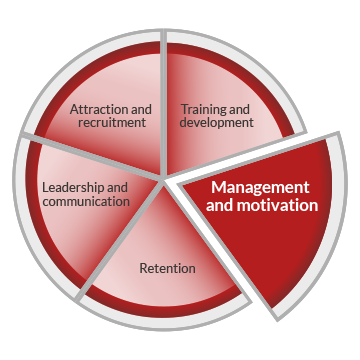The way your business and your workforce is managed has a significant influence, not just on your employees' performance but also their productivity and job satisfaction.
A well managed team will be more motivated to participate in — and contribute positively to — workplace planning initiatives and programs.
One of the most important aspects of being an effective leader and manager is the ability to create an environment that encourages and enables all employees to do their best, to achieve agreed outcomes and to feel valued.
Handling difficult situations and conflict effectively is even more important and is something many people find challenging. Some ideas for this complex aspect of workforce planning and development are explored in this section.
Motivating employees
Employees who are highly motivated are more likely to deliver higher levels of performance, work harder when workplace demands are high and have fewer absences from work. Motivated employees are loyal to their organisation, resulting in a reduction in staff turnover which reduces costs for you and usually leads to things running much more smoothly. Loyal employees deliver higher levels of customer service, more like the service you yourself might provide, resulting in greater customer retention which has a positive impact on your bottom line.
Creating a motivating work environment
Employees may be motivated by a variety of things. Some strategies for motivating employees include:
- autonomy – giving individuals freedom to work in their own way;
- responsibility – allowing people to make informed decisions and work without unnecessary supervision or checking;
- affiliation – fostering and building of relationships with colleagues and customers;
- recognition of employees’ performance and contribution - this could be through a range of rewards, bonuses, a formal reward and recognition program or simply verbal or public acknowledgement;
- access to training and development opportunities for professional and personal growth; and
- flexible work arrangements that allow employees to accommodate other personal and family interests and needs.

Rewarding employee performance
Rewarding good performance is just as important as managing, motivating and monitoring performance. Meaningful reward and recognition strategies can positively influence employee attitudes and behaviour. You may wish to consider a range of financial and non-financial rewards to attract and retain quality employees. There are also legal requirements that employers and employees must abide by.
The minimum rates of pay you are required to pay your employees are typically set by State or national awards, agreements or legislation. Often an Award will include a classification structure that dictates rates of pay for particular classes of work or specific skill levels.
Employers and employees cannot agree to lesser rates of pay that those set by an Award. However an employer may decide to pay above Award wages as an incentive to employees or to reward performance.
To attract the best employees to your business and then retain them, you may need to consider paying competitive salaries— that might include offering above Award wages.
Bonuses
Bonuses are often used as an adhoc system of financial reward. They may be irregular and linked to particular performance measures, or occur at specific times such as the end of the financial year or Christmas.
Non-financial rewards may include recognition, higher status, positive feedback, more responsibility and greater participation.
Recognition is an important non-financial reward that is particularly valued by some employees. Having efforts noticed and publicly acknowledged can be a great motivator and encourage employees to stay with an employer.
For more information and ideas about what you can do to keep your employees motivated and reward their performance check out Ways to motivate and reward your employees.
Most small to medium businesses operate in industries that are covered by the State or national Award system. Awards are legal documents that outline the wages and conditions of employment for groups of employees in a particular industry or type of work.
If an employee is covered by a particular Award, it is legally binding on you as the employer. You must provide the entitlements outlined in the Award including wages and penalty rates, hours of work, allowances and a range of other provisions.
Employers and employees cannot agree to lesser conditions or agree to ignore the Award. However, arrangements providing for pay and conditions better than those in the award are legal.
Western Australian State Awards apply to employers and employees in the State industrial relations system. For advice on whether a State Award applies to your business, call Wageline on 1300 655 266 or visit commerce.wa.gov.au/labourrelations
National modern Awards apply to employers and employees in the national industrial relations system.
For detailed information about modern Awards, or advice on whether a modern Award applies to your business call the Fair Work Ombudsman on 13 13 94 or visit fairwork.gov.au
The Workplace regulations section contains lots of information about State and national industrial Award systems, duty of care and equal opportunity and employment.
Remember there may be tax implications associated with some benefits for both you and your employee, so check with your accountant or the Australian Taxation Office.
Managing conflicts and disputes
It is good business practice to create a workplace that encourages all employees to express different/better ideas and ways of doing things. Sometimes suggestions or change may result in healthy debate, other times they may be met with opposition.
Effectively managing this process will prevent damaging conflict. Often conflict occurs because we fail to deal with a problem when it first arises.
The following are some useful techniques to use when approaching conflict resolution.
- Listen to both sides of the story and ensure you thoroughly understand the issues.
- Make sure each party stays focused on the cause of the issue.
- Avoid hiding behind policies (ensure policies reflect reasonable expectations), pulling rank and personal attacks.
- Encourage the conflicting parties to agree on some point and find some common ground.
- Stick to the facts. Do not become engaged in the argument or accusations.
- You can bring an element of calm by assuming the role of mediator.
- Sort out the easy issues first. Gaining agreement on something is encouraging.
- Keep early discussions informal and get both parties to recognise the value of the workplace relationship.
- Be creative in how you approach the resolution. The first solution may not always be the best or most appropriate.
- Aim for a genuine, mutually agreed outcome: try to create a win/win situation.
- Use formal arbitration as a last resort.
For information and resources, visit the Worksafe WA website.
Developing good conflict management and resolution skills can save your business a lot of angst, lost productivity, poor performance and interpersonal grief. It makes good business sense to resolve conflict that takes the focus of employees away from working effectively and efficiently in your business.
Bullying at work can also cause possible workplace conflict issues. Download this bullying fact sheet from Worksafe WA for guidance on how to deal with bullying in the workplace.

Managing employee performance
The best way to address employee training, development and career planning is via the employee performance management process. Managing performance is a good way to confirm that employees have the right skills, attitude and knowledge that are necessary to achieve your business objectives.
Performance management is most effective when managers and employees work together to identify where training or development needs to be directed.
Benefits of performance management
There are a number of good business reasons to regularly review your employees’ performance, including:
- staff will more clearly understand how their work fits in with your overall business goals;
- early identification, discussion and resolution of under-performance and its causes, before bigger problems arise;
- early identification of potential skills gaps and training and skill development required to overcome these gaps;
- identification of employees’ career pathways and succession planning opportunities;
- establishing good working relationships and regular communication and feedback with staff; and
- a potential reduction in absenteeism.
You can use the Job performance appraisal template to help you review the performance of your staff.
Some tips for managing employee performance
Performance management will be most successful when you:
- have realistic goals and expectations;
- allow time in everyone’s work schedule for regular performance management meetings;
- commit to the process so that managers and staff see it as important;
- monitor performance and communicate with staff on an ongoing basis so that everyone is aware of issues when they are occurring and there are no surprises;
- follow up on issues that arise during performance management discussions. This shows you have a genuine interest in the process and it will encourage future staff participation in performance management; and
- offer praise for good performance as well as identifying areas that need improvement. This helps to promote performance management as a positive experience that supports employee growth and development.
Discussions on performance issues should not come as a surprise during a formal performance appraisal. Performance issues should be dealt with at the time of occurrence and not left until appraisal time. Equally, remember to offer praise when employees produce good work.
Managing employee under-performance
There may be times when an employee’s work is unsatisfactory. While discussing this may be difficult, it’s critical to address the issue as soon as possible. There are a number of steps that may help you to manage under-performance.

Don’t let poor or unsatisfactory performance continue unaddressed, as it will be more difficult to resolve if left unchecked.
Discuss under-performance with the employee in a private meeting. Tell the employee what is unsatisfactory and ensure they understand the difference between what they are doing and what you want done. Check that they understand relevant instructions, processes or policy and performance targets. Ensure that the employee is given ample time to respond, and that it is a two-way conversation.
Give the employee an opportunity to explain the reason(s) for their performance. Under-performance may be due to lack of information or skill, job related issues or personal circumstances. Some personal circumstances may be best referred to and looked after by someone with appropriate skills or through an employee assistance program.
Agree on how the issue will be resolved, including how you can best assist the employee to develop the skills required to do the job to the standard you expect.
Make a time for review and ensure during the review that the employee knows whether they are now performing to the required standard or still have some work to do.
Always follow up and give positive feedback when the employee is working well. Managing under-performance should be seen as an opportunity for continuous improvement for the employee.
Before you start any process for managing under-performance, check your legal obligations on unfair dismissal and termination of employment.
Terminating employment
Terminating employees because of performance issues, lack of work or change in business circumstances (eg redundancy, downsizing) can be a difficult and complex process. Employees may also choose to leave your business for a multitude of reasons of their own.
To help make the leaving process easier, consult the Employee exit checklist for examples of things you may need to do when an employee leaves your business.
Note that there is a formal process involved in terminating an apprenticeship or traineeship, as the training contract is legally binding. Please refer to the Department of Training and Workforce Development Apprenticeship Office for more information.
How exit interviews can help you
Exit interviews with departing employees can be a useful source of information for your business. Knowing why someone chooses to leave may help you to make changes in the workplace so that others don’t leave for the same reasons.
The exit interview should be conducted like any other interview. Find a quiet, comfortable place where you will not be disturbed. It may be useful to have a third party conduct the exit interview to allow for an open and honest discussion.
Sometimes, people won’t want to participate in an exit interview or they may tell you what they think you want to hear. Nonetheless, giving departing employees the opportunity to have a say is very important. After all; they may be persuaded to come back at a later time, perhaps bringing with them new skills and ideas that would add value to your business.
Exit interviews may reveal things such as:
- the aspects of the job the employee enjoyed most and least;
- whether working conditions might be improved;
- if interpersonal relationships need to be managed better – for example, between individual employees or management;
- whether your recruitment, selection and induction processes are flawed or give applicants a distorted view of the job or organisation;
- if training and professional development opportunities are lacking; and
- the true level of team or organisational morale.
Consider business security
When an employee is leaving it is important to sensitively request the return of the required items, so you don’t convey disrespect or distrust. It is also important to remind departing employees of any confidentiality clauses that may have been part of their contract of employment.
The exit process should also be managed from a security point of view. Consider what needs to be returned or terminated, for example:
- name badges and identification devices;
- keys or pass cards;
- portable file storage devices and other electronic access devices; laptops and mobile phones;
- work tools and privilege cards such as a petrol card or company credit card;
- uniforms; and
- passwords and email accounts.
Ensure the exit process is as positive as possible, remember that former staff will talk about your organisation to family and friends.

More information
Employers have particular legal obligations to satisfy when terminating employment. It is essential that you know your legal obligations regarding termination, notice periods and redundancy payments before taking any action. Find out more from the following sources.
| Information on your termination obligations |
|
| Useful information about conditions of employment | |
| Useful information about termination of employment |



